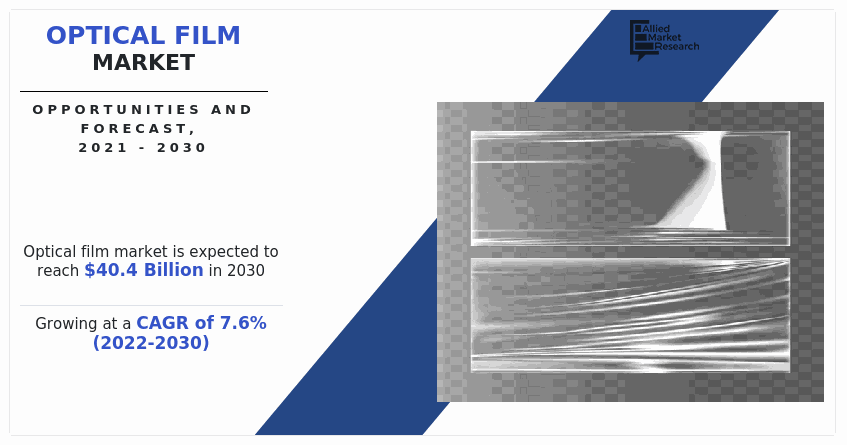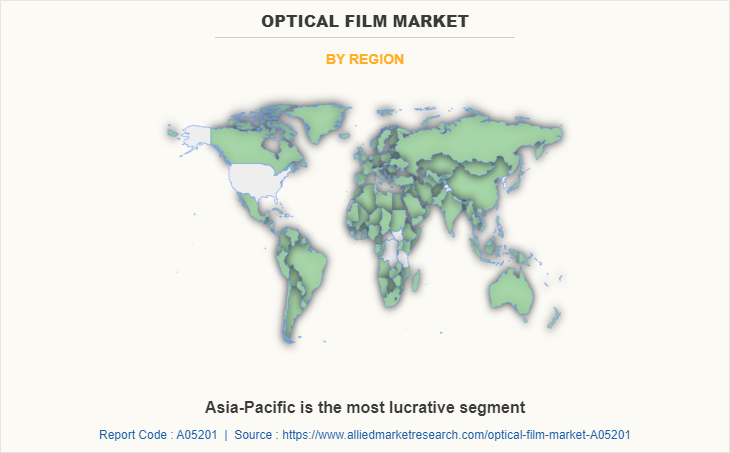Optical Film Market Research, 2030
The global optical film market was valued at $20.6 billion in 2021, and is projected to reach $40.4 billion by 2030, growing at a CAGR of 7.6% from 2022 to 2030. 
Optical films are thin films or coatings used to enhance the reflection, polarization, and transmission of various optical systems such as projection screens, mirrors, reflecting prisms, fiber-optic bundles, dispersing devices, and others. There are different types of optical films in terms of materials, refractive index, and thickness. In addition to this, there are three most common types of optical films: polarizing film, backlight module, and ITO films.
Optical films have various applications such as in TFTs (thin film transistors), LCD (liquid crystal display) panels, and OLED (organic light emitting diode) panels. Furthermore, optical films are used in desktop monitors & laptops, smartphones & tablets, television, and other large displays. Higher requirement of optical films in LCDs and LEDs among manufacturers are some of the key aspects increasing the adoption of optical films. The report highlights different factors that impact the growth of the global market such as key drivers, restraints, growth opportunities, and the role of different key players.
The global optical films market is segmented on the basis of type and application. By type, the market is classified into polarizing film, ITO film, and backlight unit film. By application market is classified into television, smartphones & tablets, desktop monitors & laptops, large format display and others. By region, the market is analyzed across North America, Europe, Asia-Pacific, and LAMEA.
The key players profiled in this report include LG Chem, Ltd., Samsung SDI, 3M, Sumitomo Chemical Co., Ltd., Zeon Corporation, Kolon Industries Inc., Nitto Denko Corporation, Toray Industries Inc., Sanritz Co., Ltd., and Hyosung Chemical.
The optical film market is segmented into By Type and By Application.
By Type
Polarizer Film is fastest growing segment
By type, the polarizing film sub-segment dominated the global optical films market in 2021, and it is projected to remain the fastest-growing sub-segment during the forecast period. This is attributed to rise in demand for polarized films in high quality display because it shows the clear image on screen. In addition to this, polarizing films are used in displays for controlling the amount of light that is reflected from the display screen. Also, polarizing films reduce the haze caused by atmosphere. Therefore, images taken by polarizing filter have high contrast and richer colors.
By Application
Television is the most lucrative segment
By application, the television sub-segment dominated the global optical films market in 2021 and is projected to remain the fastest-growing segment during the forecast period. This is attributed to high utilization of optical films in manufacturing of LEDs and LCDs which, in turn is one of the most supporting reasons for the growth of the optical film market size.

By region, Asia-Pacific dominated the global optical films market in 2021 and is forecasted to remain the fastest growing region during the forecast period. This is attributed to numerous factors such as largest production of optical films in China and Japan and wide consumer base.
IMPACT OF COVID-19 ON THE GLOBAL OPTICAL FILMS MARKET
- Sales of optical films is affected by COVID-19 owing to demolishment of businesses across the globe. Also, advanced materials sectors got highly impacted by lockdown imposed due to the COVID-19 outbreak and recorded a huge decline in terms of revenue and production in 2021 due to less workforce and disrupted supply chain.
- COVID-19 impacted almost all industries by hindering various industrial operations and disrupting the supply chain. Maximum companies halted their operations due to lack of labors. However, there is a sluggish decline in the global optical films market due to impact of COVID-19.
- Furthermore, import and export activities were significantly impacted, which, in turn, adversely affected the industries using optical films, thereby affecting the global optical films market.
- According to the United Nations Industrial Development Organization (UNIDO), 30.0%–70.0% of pre-COVID-19 workforce of various industries, such as electrical and other third-party vendors migrated to their hometowns due to uncertainties and loss of income during the lockdown. This unavailability or less availability of workforce is expected to directly affect the production and manufacturing activities, thereby resulting in a decline in advanced material industry, which in turn affected the growth of the optical films market during the forecast period.
Key Benefits For Stakeholders
- This report provides a quantitative analysis of the market segments, current trends, estimations, and dynamics of the optical film market analysis from 2021 to 2030 to identify the prevailing optical film market opportunities.
- The market research is offered along with information related to key drivers, restraints, and opportunities.
- Porter's five forces analysis highlights the potency of buyers and suppliers to enable stakeholders make profit-oriented business decisions and strengthen their supplier-buyer network.
- In-depth analysis of the optical film market segmentation assists to determine the prevailing market opportunities.
- Major countries in each region are mapped according to their revenue contribution to the global market.
- Market player positioning facilitates benchmarking and provides a clear understanding of the present position of the market players.
- The report includes the analysis of the regional as well as global optical film market trends, key players, market segments, application areas, and market growth strategies.
Optical Film Market Report Highlights
| Aspects | Details |
| By Type |
|
| By APPLICATION |
|
| By Region |
|
| Key Market Players | HYOSUNG CHEMICAL, 3M, TORAY INDUSTRIES INC., UFO DISPLAY SOLUTIONS, ZEON CORPORATION, PRONAT INDUSTRIES LTD., SUMITOMO CHEMICAL CO., LTD., POLYMER PLUS, LLC, LG CHEM LTD., MITSUBISHI POLYESTER |
Analyst Review
According to the CXOs of the leading companies, the global optical films market possesses a substantial scope for growth in the future. Continuous increase in the application of optical films in television and smart phone industry is predicted to boost the growth of the global market. However, lack of raw materials such as polycarbonate or polymethyl-methacrylate (PMMA) to manufacture optical films is a major limitation to its growth. Surge in demand for the flexible and foldable displays, especially from the developing countries, and enhancement of properties of optical films are the factors that are anticipated to drive the global optical films market. According to the CXOs, Asia-Pacific is projected to register higher growth as compared to North American and European markets.
Rapid expansion of display industry in the optical films sector, along with growing demand for well-structured and brighter display panels, may create lucrative opportunities for the market.
Polarizing film segment holds the maximum share of the global optical films market.
Technological evolution in material engineering and rapid demand for large format displays which demands the continuous implementation of technical innovations will ultimately accelerate the global optical films market growth in the next few years.
Rising popularity of foldable and flexible displays that are used in smartphones, tablets, and other electronic devices are expected to drive the adoption of optical films.
Asia-Pacific will provide more business opportunities for global optical films market in the future.
LG Chem, Ltd., Samsung SDI, 3M, Sumitomo Chemical Co., Ltd., Zeon Corporation, Kolon Industries Inc., Nitto Denko Corporation, Toray Industries Inc., Sanritz Co., Ltd., and Hyosung Chemical. are the leading market players active in the optical films market.
Agreement, business expansion, and product launch are the key growth strategies of global optical films market players.
Television, smartphones & tablets, desktop monitors & laptops, large format display industries include the major customers of global optical films market.
The report provides an extensive qualitative and quantitative analysis of the current trends and future estimations of the global optical films market from 2021 to 2030 to determine the prevailing opportunities.
Loading Table Of Content...


